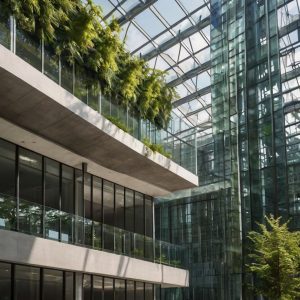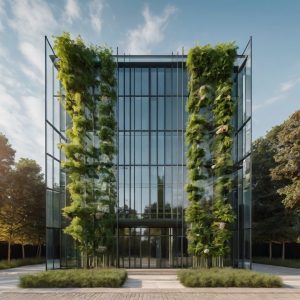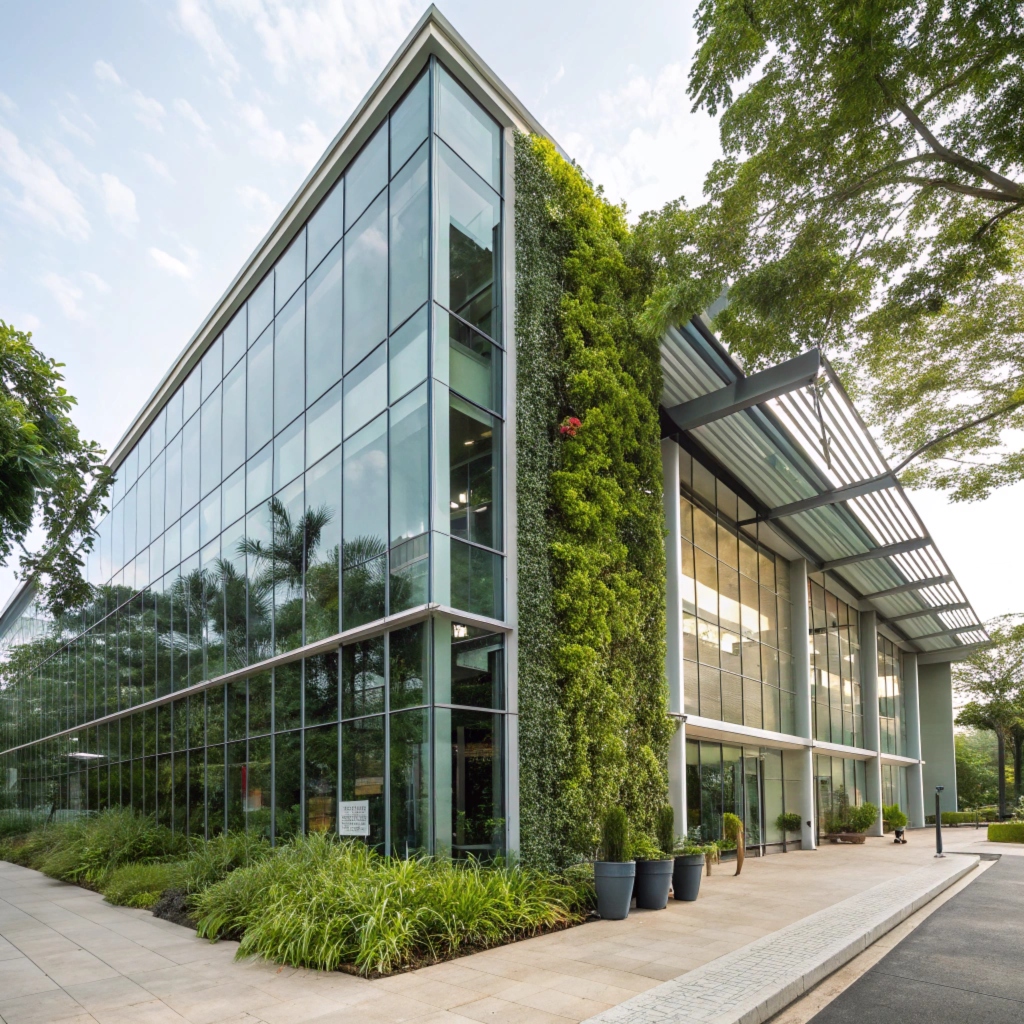
You may have heard that sustainable design is all about using renewable energy, reducing waste, and embracing eco-friendly materials. But there’s a secret ingredient to truly maximizing green living – it starts on the inside… or rather, outside.
Glass facades are more than just an aesthetically pleasing feature; they’re also incredibly durable and can withstand even the harshest weather conditions while allowing sunlight to filter in naturally.
From modern skyscrapers to eco-friendly homes, architects and builders are starting to harness the power of glass. Discover how these incredible buildings are revolutionizing urban landscapes and changing the way we live…
What is Glass and its many forms?
Glass facades, a material often misunderstood as fragile and delicate, is actually an incredibly versatile component with a multitude of forms. It can be made from sand or other materials like silicon dioxide. The type of glass most commonly used in modern buildings has been around for over 1,800 years.
This ancient form consists of silica doped with metallic oxides such that it becomes transparent and hard enough to withstand the elements and last a long time without degrading. Modern builders can make it come in many different shapes or forms by adding metal salts into molten glass, resulting in colors ranging from clear to opaque.
Glass is available as rolled sheets that are made of both tempered and laminated materials for added safety against breakage when subjected to forceful impacts. The same type may also be found in rods, tubes, and fibers which can help construct buildings without visible seams or joints.
Depending on what kind of structure it’s being used for, glass comes with different properties like transparency that allows sunlight into your home or building while keeping the outside out, providing energy efficiency and privacy.
How glass is made, green living benefits
Glass facades are making waves in modern design for their eco-friendly production methods and numerous environmental benefits. According to the US Energy Information Administration (EIA), replacing old windows with insulated glass units can reduce heat transfer by up to 70% and increase overall building efficiency.
By utilizing this technology, buildings not only minimize energy waste but also create healthier indoor environments. Insulated glass units can significantly regulate temperature fluctuations, ensuring optimal working conditions for occupants. Moreover, the inclusion of soundproofing properties enhances residents’ peace of mind.
Incorporating sustainable design elements into your home or workspace is made easier with tempered glass’s recyclability rates reaching up to 95%. The International Association of Certified Home Inspectors indicates that such practices decrease greenhouse gas emissions from manufacturing processes. This aligns with the broader goal of reducing carbon footprint.
Tempered glass can also contribute to energy efficiency by maintaining indoor temperature levels, thus requiring less air conditioning in warmer climates and heating systems during colder seasons. With proper installation, you’re able to conserve resources while elevating your building’s aesthetic appeal.
Think about the last time you opened curtains on a chilly morning to let in some sunshine. Glass facades aren’t just aesthetically pleasing; they’re eco-warriors that save energy by regulating indoor-outdoor temperature fluctuations and sound pollution.
Imagine walking into an office with walls that filter natural light like solar panels but in reverse: they harness the power to minimize direct sunlight’s negative effects. That’s exactly what glass facades don’t just by providing energy efficiency, but also enhancing interior comfort while reducing glare
Eco-Friendly vs. Traditional Building Materials
Glass facades stand out as a top choice for modern building design due to their durability, sustainability, and aesthetic appeal. But is glass truly the more eco-friendly option? Let’s dive into some compelling examples that demonstrate its benefits.
Examples Supporting Main Point: Weighing Glass Facades Against Traditional Materials
When it comes to choosing materials for your next project, recycled glass facades offer a unique selling point: they can be repurposed and reused from an old building’s demolition, reducing waste and the demand on virgin resources. Take for instance the renovation of the iconic Sydney Opera House in Australia. The original structure was clad with concrete and steel, but when it underwent renovations in 2003, architects opted for a new glass facade that not only updated its look but also significantly reduced energy consumption.
Another notable example is the Amazon Spheres development in Seattle. This innovative office building boasts over 40,000 plants on the exterior of its 78-foot-tall walls, creating a lush oasis amidst the city’s concrete jungle. The structure’s translucent panels provide natural light while minimizing direct sunlight entry into the interior space, reducing cooling costs.
Lastly, consider the solar-powered windows developed by startup company Solyndra. These solar-powered glass facades use photovoltaic technology to generate electricity from natural light, significantly decreasing energy consumption in commercial and residential buildings.
Glass also provides excellent thermal insulation which makes it an ideal material for modern architecture. Different types of glass facades can achieve optimal energy efficiency through their unique properties: Single-glazed glass offers minimal heat transfer, while insulated glass combines two panes of clear glass with a gap between them to reduce convection currents and minimize radiation loss.
By choosing the right type and design of sustainable building practices, we can significantly impact climate change. For example in cities like Tokyo where buildings account for a significant portion of CO2 emissions through heat gain due to high temperatures during summer months; using materials that are thermally efficient would make an immediate difference when it comes to reducing carbon footprint
The Role of Glass in Climate Control

Glass facades have become a staple in modern sustainable design, offering more than just aesthetic appeal. By regulating indoor temperatures and reducing artificial lighting needs, they play a crucial role in energy-efficient building design.
A single pane of clear glass can reduce summer energy consumption by up to 25% due to the thermal mass properties. For instance, a study conducted in Germany found that using glass facades with high solar gain potential resulted in an average savings of¬1.3 million on heating and cooling bills per year. Imagine being able to enjoy natural light without worrying about hefty electricity bills or freezing office spaces during winter months.
But the relationship between clear glass and temperature regulation isn’t entirely straightforward. When sunlight pours into a room through single-pane windows, it’s like a welcome party for bacteria in more ways than one! During warmer months, the sunbeams streaming through are lovely for people-watching and taking in views of nature outside. However, during colder months or at night when direct sunlight isn’t available, temperature drops can become starkly cold.
To mitigate this issue, designers can incorporate clever tricks like thermal mass systems that absorb and release heat slowly over time. These materials help regulate indoor temperatures without compromising energy efficiency.
For example: a study published in the Journal of Building Engineering found that using phase-change material-based glass facades reduced winter heating demands by 15% while maintaining summer cooling needs at an average of -10%. Such innovative designs not only improve occupant comfort but also reduce carbon footprints. This concept can be seen in high-rise buildings with transparent exterior claddings, showcasing the beauty of thermal mass.
Glass facade design often walks a fine line between letting sunlight flood into the space and managing temperature drops during colder months or at night. However, designers have developed clever solutions to address these concerns.
Shading devices like overhangs, awnings, and louvers can help regulate natural light while preventing overheating in summer. For instance, building architects in Singapore integrated solar-powered shades that automatically adjust according to sunlight intensity for maximum energy savings during peak hours.
To make the most of glass facades’ benefits, we must balance their potential drawbacks with thoughtful design decisions. As such, incorporating clear glass into sustainable architectural strategies can transform not just buildings but also people’s daily lives turning what was once an uninviting space into a comfortable oasis that fosters well-being and creativity.
Imagine walking through the office of your dream workplace on a cold winter morning to find bright windows streaming sunlight onto your workspace. As you look up, the sky outside is overcast, casting long shadows across buildings in the distance but inside, everything feels cozy and inviting thanks to cleverly designed glass facades that allow maximum natural light while maintaining optimal indoor temperatures.
Glass facades have become a staple in modern sustainable design, offering more than just aesthetic appeal. By regulating indoor temperatures and reducing artificial lighting needs, they play a crucial role in energy-efficient building design.
Sustainable Urban Planning with Glass Facades
Glass facades offer a unique opportunity to rethink traditional building materials and create a positive relationship between architecture and nature. Glass facades can serve as a natural insulation layer in buildings, capturing solar heat during winter months. A study conducted by the University of California found that single-glazed windows reduce heating energy consumption by 45% in northern climates.
By optimizing passive solar collection through strategic placement and materials selection, building designers can harness this benefit while minimizing summer heat gain. For instance, incorporating low-E coatings or specialized glazing into a glass facade design can significantly reduce thermal transmission. This results in more comfortable indoor temperatures for occupants without the need for additional heating or cooling systems.
Think of glass facades as nature’s own insulation system; they allow sunlight to warm buildings naturally during winter months, reducing energy consumption by up to 45% (as found in a study conducted at the University of California). Moreover, these passive solar collectors can be designed to provide natural ventilation, further minimizing heat gain and associated energy use.
Incorporating green roofs into a sustainable design strategy not only captures rainwater but also provides additional habitat for urban wildlife. Studies have shown that green spaces in cities like Chicago can increase oxygen levels by up to 20% and mitigate heat island effects. By integrating glass facades with built-in gutters and downspout systems, buildings can efficiently collect and store rainwater for non-potable uses.
A well-designed glass facade is an efficient way to create a more sustainable living environment while reducing energy consumption. For example, the Solar Building Concept in Austria features a building covered in over 20 green roofs that capture up to 80% of rainfall during peak storm events. Not only do these green spaces help reduce stormwater runoff but also provide insulation and mitigate urban heat island effects.
Incorporating low-E coatings or specialized glazing into a glass facade design can significantly reduce thermal transmission, resulting in more comfortable indoor temperatures for occupants without the need for additional heating or cooling systems. By understanding how to harness passive solar collection through strategic placement and materials selection, architects and designers can create buildings that not only minimize energy consumption but also promote sustainability in urban areas with limited access to clean drinking water resources.
How to Build a Green Home using Glass

Glass facades are increasingly becoming an integral part of sustainable building practices, with 75% of new buildings now incorporating glass in their design due to its energy-efficient benefits. According to recent studies, green buildings that feature glass facades not only reduce environmental impact but also enhance occupant experience.
One way to build a greener home is by incorporating tinted or low-E glass in windows and doors. This type of glazing can significantly lower energy consumption while maintaining optimal levels of natural light. For instance, using Low-E glass in double-glazed units reduces heat transfer by up to 70%, leading to significant energy savings over time.
When it comes to building a green home with tinted or low-E glass, consider selecting the right type and quality. This is where some builders have been able to achieve remarkable results. For example:
- Tinting: Using Laminated glazing can help reduce solar radiation by 30%, reducing heat gain in summer months.
- Low-e coatings: These significantly lower energy consumption while maintaining optimal levels of natural light, creating an ideal indoor environment.
When it comes to integrating glass facades with other eco-friendly materials, consider pairing them with recycled aluminum or FSC-certified wood. This combination provides a perfect blend of sustainability and durability.
To maximize the benefits of green building, focus on combining eco-friendly materials like Low-E glazing systems, solar panels, or passive cooling techniques that utilize natural sunlight to regulate indoor temperatures. Some types of glass contain added benefits such as UV protection and enhanced security features which can increase the durability and longevity of your sustainable structures.
For instance:
- Solar windows: Using high-performance coatings on window panes increases thermal insulation by up to 40%.
A well-designed green home that incorporates passive solar heating and cooling systems, in addition to glass facades, will not just benefit the environment but also create a healthier indoor space for occupants. It’s time to harness the potential of sustainable building practices.
Glass and Water Conservation Strategies
Glass facades have become a staple in modern architecture, but their primary function should not be solely focused on aesthetics. When it comes to incorporating sustainable materials into building design, there are several strategies that can significantly reduce energy consumption and promote green living.
One of the most effective ways to achieve this is through the use of low-e coatings or insulated glass units (IGUs). These types of glasses have been shown to minimize heat transfer between inside and outside environments, resulting in substantial cost savings. For instance, by using a single layer with an anti-reflective coating on one side and another layer without any reflective coating on the other side can significantly reduce energy loss through conduction.
Low-e coatings are particularly useful as they provide thermal insulation while still allowing natural light to pass through the glass. This allows building owners to enjoy the benefits of daylighting while maintaining a reduced energy consumption during both heating and cooling periods, thereby reducing costs associated with lighting needs which is estimated to account up to 20% in many commercial buildings.
Another way that architects can promote green living when designing modern architecture is by using double-glazed windows. These types of windows have been shown to provide more insulation than traditional single pane glass, significantly reducing the energy consumption for heating and cooling during both winter and summer months. In addition to their insulating properties, double-glazed windows also help in minimizing water consumption due to reduced artificial lighting needs.
Double glazing can be further enhanced by using laminated or tempered glass options with high R-values such as 4-5 units of thermal performance (U-value). These types of glasses are particularly beneficial when used together with low-e coatings, providing excellent insulation and energy efficiency. By incorporating these materials into the design of a building they can significantly reduce heating costs in both residential homes and commercial buildings.
The material choice alone should be enough reason to consider using glass facades that incorporate green technologies such as greenhouse gases reduction or natural light promotion through their ability to allow for more efficient solar heating/cooling. Glass can help reduce greenhouse gas emissions by allowing natural light into a building while reducing the need for artificial lighting, which is an important factor in minimizing carbon footprint.
By incorporating these strategies and materials, you’ll not only create energy-efficient buildings but also contribute to a more sustainable environment.
And here are some specific ways that using low-e coatings can lead to cost savings:
- Energy consumption reduction: By providing insulation against both heat loss and gain during winter months as well summer months the use of low e coated glass units results in substantial cost saving due to reduced heating costs which is estimated to be around 25% less energy usage than single glazed windows.
- Longer equipment life: Low-e coatings reduce the degradation process caused by extreme temperatures, thus reducing replacement rates of components and minimizing maintenance needs. This can lead to a reduction in operational expenses over time.
- Improved occupant experience: With low e-coated glass units providing better insulation while maintaining natural light into buildings they allow occupants to work more efficiently without discomfort or distractions.
In conclusion, using green technologies such as greenhouse gases reduction through their ability to promote natural lighting and reduce the need for artificial lighting is an essential part of building design.
Disaster Resistance and the importance of glass

Glass facades have become a game-changer in disaster-resistant design, providing unparalleled protection against natural disasters like earthquakes and hurricanes. The damage they can prevent is staggering imagine walking into a building after an earthquake. The sound of shattering windows and creaking steel is unnerving. But what if that was prevented? With the right design, your building can be more than just safe; it’s resilient.
Glass stands out as a top choice for disaster resistance due to its unique ability to absorb rather than transmit forces generated during seismic events or other disasters. This property minimizes potential damage, reducing the likelihood of structural collapse and subsequent devastation. In fact, studies have shown that glass facades can reduce damage by up to 50% in the event of a seismic disaster.
But what makes glass even more appealing is its versatility. Designers can craft safety features tailored to specific needs, such as wind resistance or thermal expansion. For instance, laminated and tempered glasses are used in conjunction with advanced glazing systems that provide added security against flying debris and other hazards. It’s not just about being safe; it’s also about being prepared for the unexpected.
When designing glass facades for disaster-prone areas like Japan or California, architects can draw from real-world examples to inform their decisions. The city of Tokyo, with its high earthquake risk, has built many buildings featuring glass-reinforced designs that have performed impressively under seismic tests. Similarly in Miami, where hurricanes are a regular threat, developers prioritize impact-resistant glass for added security.
For instance, the iconic Burj Khalifa in Dubai features an advanced glazing system designed to withstand extreme winds and debris from severe storms. This remarkable example demonstrates how architects can think creatively about disaster resistance while maintaining style and elegance.
Of course, there’s no denying that a higher upfront cost comes with designing glass facades for resilience. However, the long-term benefits far outweigh these initial expenses. Maintenance is reduced when you factor in features like self-cleaning coatings and durable materials that minimize the need for repairs.
As architects continue to push innovation in building design, it’s crucial we consider all factors of a structure including natural disasters to ensure our buildings are not just safe but truly resilient.
Green Infrastructure, how does it use glass

Making sustainability the new norm in architecture has never been more important. Glass facades play a critical role in modern building design as they bring unparalleled energy efficiency and aesthetic appeal. The eco-friendly features of these structures have captured the attention of environmentally conscious architects, who now prioritize them for their buildings.
Green Infrastructure’s use of glass offers significant environmental benefits that should not be ignored. Not only can it reduce heat gain during summer months, but it also allows in natural light year-round, eliminating the need for artificial lighting systems and reducing energy consumption. Furthermore, this sustainable option is non-porous and resistant to corrosion from pollutants.
For architects who want their buildings to thrive with reduced environmental impact, incorporating green glass facades into a design should be a top priority. The use of such eco-friendly materials not only benefits the planet but also serves as an attractive feature for businesses looking to appeal to environmentally-conscious clients. By embracing this option, modern architecture can elevate its sustainability credentials and provide healthier indoor spaces.


